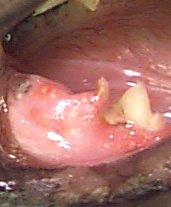Cat Losing Teeth
"Cat losing teeth could be due to gingivitis forming on and then eroding teeth. A condition called FORL occurs in 75% of cats 5 years of age and older and is due to advanced gingivitis."
The care of cat teeth is similar to the required care for human teeth including brushing and periodic cleaning by your veterinarian. If teeth aren't cared for problems are also similar to humans including gingivitis, plaque and the possible loss of teeth from the resulting gum disease.
Cat Losing Teeth Symptoms
When cats lose their adult teeth, it is generally due to periodontal (gum) disease. Other symptoms of cat losing teeth include: * Bad breath
* Drooling saliva (may be tinged with blood)
* Loss of appetite
* Difficulty chewing food
* Mouth pain (pawing at mouth or rubbing side of face on the floor)
* Red, inflamed gums
* Receding gums, showing exposed tooth root
* Yellow or brown deposits on teeth at the edges of the gums
* Inability to close mouth
Cat Losing Teeth Diagnosis
If your cat has any of the above symptoms, or if she loses any teeth, you should take her to the vet. The vet will inspect her teeth and gums carefully. No special tests are needed.A majority of cats older than 5 years old get a condition called feline ondoclastic resorptive lesion (FORL). This condition is due to gingivitis and causes the teeth to form a cavity and then ware away. This condition can cause lesions, bleeding and possibly spasms of the jaw. If caught early these teeth can be treated in a similar way that a cavity is filled for a human.
Picture of Cat Losing Teeth

Cat Losing Teeth Treatment
Once your cat loses a tooth, there is no way to replace it. Preventative care is of utmost importance. In the case of a crack or cavity, the tooth needs to be repaired or pulled.You should brush your cat's teeth two or three times per week. Use toothpaste made for Cats and toothbrushes made for cats.
Make sure you take your cat to the vet for her annual check-ups, so her teeth can be examined. If your cat's teeth need to be cleaned, your vet will do this under anesthesia. If any teeth are very loose or severely infected, your vet may need to extract them. Otherwise, antibiotics may be prescribed for gum infections.
A dietary supplement that focuses on teeth and gum health might be helpful. Consider a supplement such as Pet Alive Gums-n-Teeth which is formulated to help prevent cat gingivitis.
Cat Teeth Cleaning and Brushing
1. Have your cat get used to you putting things in his mouth. Dig your finger in something tasty, like beef bullion. Put your finger in your cat�s mouth and move it in a circular motion over her teeth and gums. Do this several times a week, and after a few sessions your cat will be comfortable with having your finger in her mouth.2. Now place a gauze pad around your finger and repeat the procedure. You can dip the pad in the beef bullion so your cat enjoys the taste. After a few sessions, your cat will be comfortable with this procedure.
3. Next, let your cat get used to the toothbrush you are going to use. Finger toothbrushes are the easiest to use. Finger toothbrushes do not have a handle but fit over your finger (they look sort of like a thimble). You can find them at pet stores or get them from your vet. Let your cat lick something tasty off the brush so she gets used to it.
4. Now let your cat get used to the toothpaste. Use a pet toothpaste, not a human toothpaste. People toothpaste will upset your cat's stomach and your cat will not like the flavor. Pet toothpaste comes in flavors like poultry and malt and your cat will like the taste. Let your cat lick some off your finger and then off the toothbrush.
5. Now that your cat is used to having your fingers in her mouth and is used to the toothbrush and toothpaste, you are ready to begin brushing her teeth. Start with just a few teeth at a time. The upper canines (the large ones at the front of the mouth) are good ones to start with. Over time you can begin brushing more and more teeth until you can brush them all. Give your cat lots of praise. You can also give her a treat after brushing her teeth to reward her.
Sources
Brushing Teeth and Home Dental CareNash, Holly DVM
Picture courtesy of
Dentalvet
From Cat Losing Teeth to More on Cat Teeth
To Cat Health Guide Home